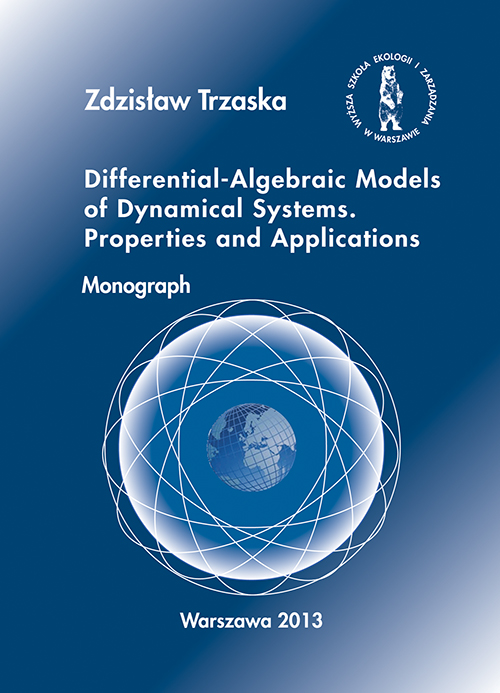O publikacji
O publikacji
Autor: Zdzisław Trzaska
Wyd.: 2013
The aim of this book is to provide basic definitions and tools for the application of differential algebraic equations (in short DAEs) figured in modelling and the analysis of dynamical systems. Currently, this is one of the principal challenges at the crossroads between mathematics, physics and computer science. Over the last three decades general interest in such a tool has experienced continuing growth. At present we can find many conferences, symposia, workshops, or special sessions, as well as papers and special issues in recognized journals, devoted to theoretical and application aspects of differential algebraic equations. On the other hand, motivation for this growing interest has been in engineering applications, as can be observed at such conferences and in such journals, especially those regarding control engineering.

More recently, there has been growing interest in investigations concerning the chaotic behaviour and dynamics of fractional-order differential algebraic equations. The book combines the features of a graduate-level textbook with those of a research monograph and survey of the recent results on analysis and geometry of differential-algebraic equations in the real domain. Exposition of each topic begins with basic definitions and reaches the present-day level of research on many occasions. Traditionally, the proof of many results of analytic theories, of differential equations are very technically involved. Whenever available, we have tried to preface formulas using motivations and avoiding, as much as possible, all cumbersome and non-revealing computations. The basic purpose of this book is to present a concise introduction to the basic methods and strategies in differential algebraic equations and to enable the reader to catch up with the state of the art developments in this field and also to participate and contribute in the development of this exciting research area. In contrast, to other monographs on this subject, which mainly deal with the mathematical foundations of differential algebraic equations, this book is devoted to the application of fractional calculus on physical problems.
While the research area of DAEs is relatively new, much work has been done to qualitatively analyze DAEs in their typical theoretical forms, such as, the quasilinear, semi-explicit, or Hessenberg. Another topic relevant do DAEs is that of numerical methods to their solutions. Many known ODE solvers have been adapted to solve DAEs. The applicability of those solvers depends on the structure of DAEs and their properties. Typical mathematical software packages, such as, Matlab, Maple and Mathematica are included as own DAE solvers. Matlab scripts and plots are extensively used in this book to illustrate basic concepts and examples. We believe that most DAEs presented in this book can be used for testing purposes when a new numerical DAE solver is developed, or new interesting features and properties of DAEs are discovered. We intend to show practical systems of DAEs as they occur in many applications, such as, in electrical engineering (circuits and power systems), fluid flow problems in gas dynamics, magneto-hydrodynamics and spray dynamics. These applicable areas, proved to be filled with many interesting DAEs in various structures and forms. In addition, a chapter is included on fractional-order DAEs as an alternative to practical robustness trade-offs.
The book is primarily aimed at graduate students and professionals looking for a quick and gentle initiation into this subject. Yet, experts in the area will find several results here whose complete exposition has never published before in a book. Therefore, it is our hope that this book will be read by, and of interest to, a wide audience, ranging from specialists in the theory of differential algebraic equations to originators of numerical scripts. The words of sincere thanks I offer to Prof. Dr. Hab. Eng. Jerzy Klamka, a reviewer of the manuscript, for many valuable comments and suggestions, which have contributed to the elimination of defects occurring in monograph text. I wish to thank all of the editors and their assistants at the Publishing Office of the University of Ecology and Management in Warsaw for the work they have done in bringing this project to fruition.
